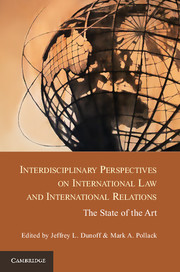 Interdisciplinary Perspectives on International Law and International Relations
Interdisciplinary Perspectives on International Law and International Relations Published online by Cambridge University Press: 05 January 2013
Political scientists and legal scholars have increasingly explored the concepts of hard and soft law in international governance. Although the concept of soft law remains to some extent controversial in the legal academy, the burgeoning literature of the past decade has generated valuable insights regarding the adoption of hard and soft law as a design choice, the advantages and disadvantages of each form under different conditions, the ways in which hard and soft legal instruments interact over time, and the impact and effectiveness of hard and soft legal provisions in various issue areas.
In this chapter, we review and assess this literature, with a focus on the insights generated by interdisciplinary international law/international relations (IL/IR) scholarship. The first four parts cover the four core areas of IL/IR theorizing about hard and soft law: definition, design, interaction, and impact. That is, we first address a key definitional question, noting the substantial disagreements among positivist, rational institutionalist, and constructivist scholars about the definitions and the key features of hard and soft law, respectively. Next, we examine the question of hard and soft law as a design choice, asking under what conditions states (or other actors) might opt for hard- or soft-law commitments in international relations. Here, we distinguish between a nearly ubiquitous functionalist approach and a nascent but promising distributive approach distinctive to contemporary IL/IR scholarship. Third, we examine the question of how hard and soft law interact in an increasingly complex and fragmented international legal landscape, arguing that hard and soft law can interact not only as alternatives or complements, but also, under certain conditions, as antagonists. Fourth, we examine the sparse but suggestive scholarship on the impact of hard and soft law beyond the law-making stage (i.e., in terms of legal interpretation, as well as compliance and effectiveness). A brief final section concludes with a discussion of the value-added contributions, as well as the lacunae and blind spots, of the IL/IR literature in this area.
To save this book to your Kindle, first ensure [email protected] is added to your Approved Personal Document E-mail List under your Personal Document Settings on the Manage Your Content and Devices page of your Amazon account. Then enter the ‘name’ part of your Kindle email address below. Find out more about saving to your Kindle.
Note you can select to save to either the @free.kindle.com or @kindle.com variations. ‘@free.kindle.com’ emails are free but can only be saved to your device when it is connected to wi-fi. ‘@kindle.com’ emails can be delivered even when you are not connected to wi-fi, but note that service fees apply.
Find out more about the Kindle Personal Document Service.
To save content items to your account, please confirm that you agree to abide by our usage policies. If this is the first time you use this feature, you will be asked to authorise Cambridge Core to connect with your account. Find out more about saving content to Dropbox.
To save content items to your account, please confirm that you agree to abide by our usage policies. If this is the first time you use this feature, you will be asked to authorise Cambridge Core to connect with your account. Find out more about saving content to Google Drive.